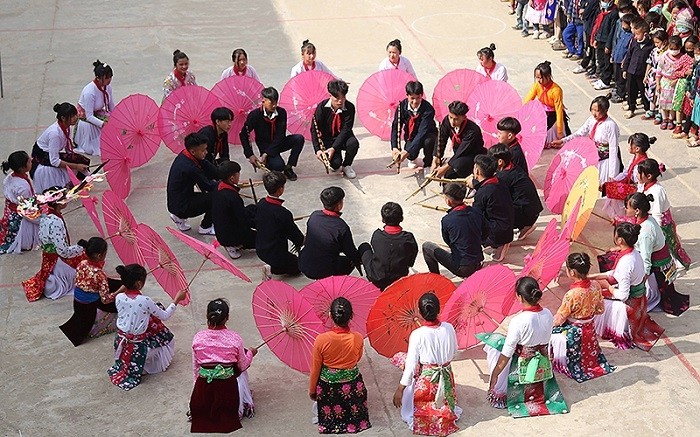The Ho Chi Minh Communist Youth Union and the Vietnam Youth Federation have worked with authorities of border localities to deploy action plans, programmes, and projects on safeguarding the unique cultures of ethnic people.
Prominent among them is the ‘Bringing Traditional Culture Closer to Schoolchildren’ project, which aims to help students learn more about traditional cultural values, thus raising their role in preserving and upholding folklore culture while eliminating outdated customs.
The Can Chu Phin boarding school in Can Chu Phin Commune, Meo Vac District, in the northern province of Ha Giang, is providing education for hundreds of children from various ethnic groups including H’mong, Pu Peo, Pa Then, Lo Lo, Co Lao, Giay, and Dao.
According to Hoang Le Nhung, the school’s rector, in response to the ‘Bringing Traditional Culture Closer to Schoolchildren’ project, various folk games such as stick pushing and danh yen (a game similar to badminton using a shuttlecock made of bamboo affixed with some feathers) are staged during breaktime for students at the school.
The students are also taught to play traditional musical instruments, sing folk songs, and perform folk dances of ethnic groups in the locality.
A ‘khen’ (panpipe) club was established in 2013, and a space to introduce indigenous cultures of ethnic groups was put into operation at the school, attracting great interest and enthusiastic participation from students.
 |
Elementary students at a school in Quan Ba District, Ha Giang Province, learn to play panpipes – a traditional musical instrument of H’mong ethnic people (Photo: baohagiang.vn)
Vu Duc Hai, a fifth grader at the school, said that he has been learning to play panpipe for about a year now and has become more passionate about this art form. Cultural activities hosted by the panpipe club provide opportunities for him and other club’s members to learn, play and have fun at the same time.
The provincial authorities of Ha Giang have held that culture’s essential role in socio-economic development and the preservation and promotion of cultural values of ethnic groups is an important, regular and long-term task.
According to Director of the Ha Giang Provincial Department of Culture, Sports and Tourism Nguyen Hong Hai, in a bid to safeguard traditional culture, the department has opened many classes on teaching the embroidery techniques used on costumes of the Lo Lo, Dao, and Tay ethnic groups; playing traditional musical instruments of the H’mong and Tay people; and singing folk songs to locals, particularly young people.
The department has also carried out research on the worship ritual for the god of the forest of the Co Lao ethnic group in Sinh Lung Commune, Dong Van District, and the weaving craft of the La Chi ethnic people.
In addition, the department has coordinated with the provincial Department of Education and Training to promulgate a set of educational materials on improving life skills and bringing traditional culture to schools.
















